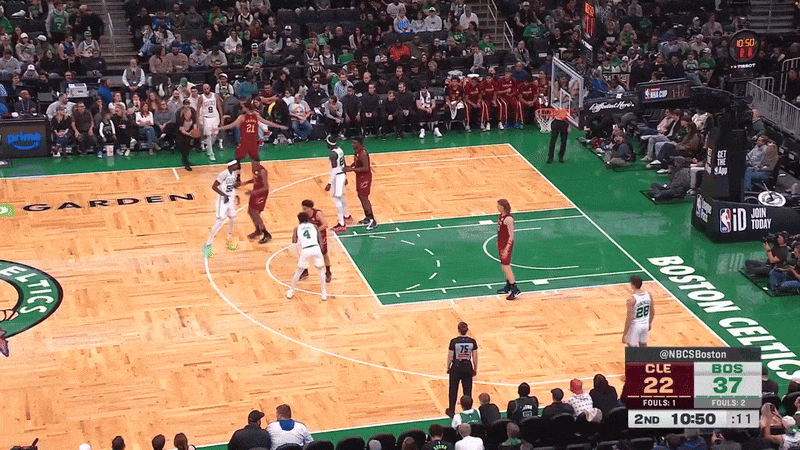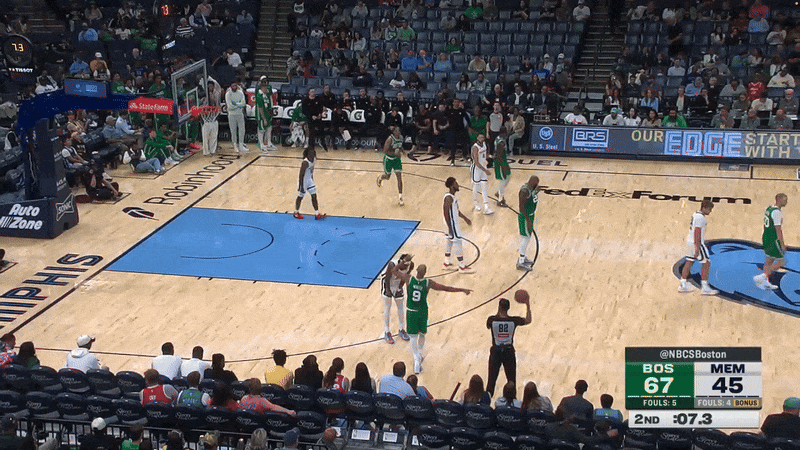Boston Celtics Playbook: Some New Sideline Entry Plays
Joe Mazzulla has added two new actions to his Sideline Out-Of-Bounds playbook.
*I made the decision during the summer that this newsletter wouldn’t be primarily focused on Xs and Os. I want it to have something for everyone. With that said, I’ll be running some polls at the end of each article for the next few weeks. Please take the time to vote on them, it only takes a few seconds.**
Since Joe Mazzulla stepped into the Boston Celtics head coaching role, he’s typically stuck to two or three sideline out-of-bounds (SLOB) plays. During the 2023-24 season, en route to a championship, Mazzulla’s go-to sideline action was known as “Slice.”
That action looked like this:
Typically, when the Celtics ran this action, Jayson Tatum was the inbounder and the slice screen — which is just a back screen on the wing — freed Tatum up to get the ball back, usually on or near the low block or mid-block. It’s a simple action, with a few variants, but in general, it worked well for the Celtics, as Tatum’s gravity always put the defense on its heels.
This season, Mazzulla appears to be leaning into something similar in these SLOB sets, but with some slight variations. Over the last two preseason outings, Boston has primarily run a “Slice Veer” set when inbounding from the sidelines.
Nevertheless, let’s take a quick look at the new SLOB entry, so we can see how it evolves as the season progresses.
Above is how the action looks when run in real time. Below is an annotated version to break it down a little more.
**I have Queta as option one here. After more film work, he will be option 2, the player who receives the veer screen appears to be the primary option**
One of the biggest differences in the action is that the slice screen occurs before the inbounds, rather than after. The idea, from what I can gather, is that the slice screen gets a shooter into the strong side corner, while the veer (a screen that flows into another screen) is designed to create two high-quality entry passes for the inbounder.
In the above clip, Neemias Queta offers an easy entry to the elbow, where he can either attack or redirect the rock via a pass or dribble hand-off. The second inbound option is for the guy receiving the veer screen, which in this case is Luka Garza. Ideally, the second option would create a little more separation. Nevertheless, you have a big on the elbow and a shooter near the logo.
If all else fails, there’s another shooter in the far-side corner.
I would assume inbound to the slice screen receiver is discouraged, as his defender is closest to the passing line — turnover city.
Here’s another example. The entry to the play is exactly the same. Slice the screen for Baylor Scheierman into a veer screen for Payton Pritchard. The inbound finds Pritchard, who is option 1, and now the play can unfold.
What I like about a sequence like the one above is that there’s a clear trigger point. You can see that as soon as Pritchard’s drive is cut off by the defense, it triggers a back cut from Chris Boucher. I’m not sure if that’s a coached aspect or just a good read from a veteran, but either way, it’s a solid approach to keeping a play alive. You’re essentially giving the action new life by using the dead drive as the trigger point for the cut.
Different game, same inbound action. This time, it’s Anfernee Simons who receives the veer screen to collect the ball at the logo. The Cleveland Cavaliers do a good job of hedging on the very high pick-and-roll, leading to Simons getting the ball out of his hands.
So far, the action has failed to yield many positive results. However, we’re in the preseason, with a string of new faces; it will take time for plays like this to not only become second nature but also something the offense can exploit to its advantage. Nevertheless, I do like the play, as it gives you multiple inbounding options and a couple of different reads. If teams switch either of the entry screens, it should make life easier, as mismatches can be addressed early.
We have seen another new entry play…But only once or twice over the three games. I still want to point it out here, both because it could become a staple down the line and because I actually really liked the concept, being the nerd that I am.
I call this action Split Corners. The play starts with the weakside corner guy cutting to the top of the perimeter before initiating a split cut with another shooter or ball-handler. The weakside guy relocates to his original spot on the floor, and the other player — Jaylen Brown in this instance — makes his own cut toward the strong side corner, where he receives the inbound pass.
The action occurs just outside of a screener's shoulder, allowing the screener to create some separation for the player to receive the inbounds pass.
I’m a big fan of this action, as it gives a scorer an opportunity to receive the ball in rhythm and the time and floor spacing to make a read, whether to drive, post up, shoot over, or hit the open man.
Both the “Slice Veer” and “Split Corners” actions have scope to be impactful plays for the Celtics out of Sideline Out-Of-Bounds plays. I also think “Split Corners” could work during Baseline Out-Of-Bounds (BLOBS) actions, too, although it may need some variations.
I would also expect the Celtics to run some standard “Slice” actions, too. After all, why fix something that isn’t broken?
We’re not even into the regular season yet, but we’re already seeing Mazzulla add some tweaks to his playbook. I’m really looking forward to seeing what else he’s got up his sleeve, especially if those actions help put some wins on the board.


![[video-to-gif output image] [video-to-gif output image]](https://substackcdn.com/image/fetch/$s_!obXf!,w_1456,c_limit,f_auto,q_auto:good,fl_lossy/https%3A%2F%2Fsubstack-post-media.s3.amazonaws.com%2Fpublic%2Fimages%2F61b57149-ac75-40ce-9ac8-a250ce205086_800x450.gif)
![SLOB Slice Veer - TO.mp4 [video-to-gif output image] SLOB Slice Veer - TO.mp4 [video-to-gif output image]](https://substackcdn.com/image/fetch/$s_!PcEO!,w_1456,c_limit,f_auto,q_auto:good,fl_lossy/https%3A%2F%2Fsubstack-post-media.s3.amazonaws.com%2Fpublic%2Fimages%2Fddd47d52-334b-4a56-9d8f-de21f1424c05_800x450.gif)
![SLOB Slice Veer Boucher baseline cut.mp4 [video-to-gif output image] SLOB Slice Veer Boucher baseline cut.mp4 [video-to-gif output image]](https://substackcdn.com/image/fetch/$s_!VUrd!,w_1456,c_limit,f_auto,q_auto:good,fl_lossy/https%3A%2F%2Fsubstack-post-media.s3.amazonaws.com%2Fpublic%2Fimages%2Feffe764e-fc26-4d3b-8188-4f077e3f4a57_800x450.gif)

